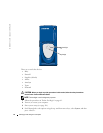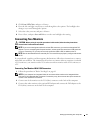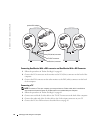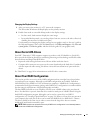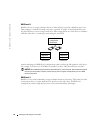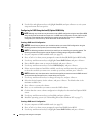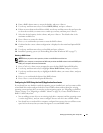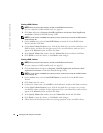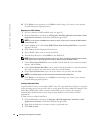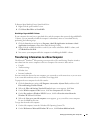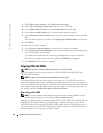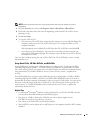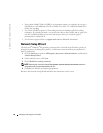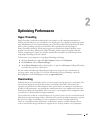
22 Setting Up and Using Your Computer
www.dell.com | support.dell.com
Creating a RAID 0 Volume
NOTE: When you perform this operation, all data on the RAID drives will be lost.
1
Set your computer to RAID-enabled mode (see page 19).
2
Click
Start
and point to
Programs
→
Intel(R) Application Accelerator
→
Intel Application
Accelerator
to launch the Intel(R) Storage Utility.
NOTE: If you do not see an Actions menu option, you have not yet set your computer to RAID-enabled
mode (see page 19).
3
On the
Actions
menu, select
Create RAID Volume
to launch the Create RAID Volume
Wizard, and then click
Next
.
4
On the
Select Volume Location
screen, click the first hard drive you want to include in your
RAID 0 volume, and then click the right arrow. Click a second hard drive until two drives
appear in the
Selected
window, and then click
Next
.
5
In the
Specify Volume Size
window, click the
Volume Size
desired, and then click
Next
.
6
Click
Finish
to create the volume, or click
Back
to make changes.
Creating a RAID 1 Volume
NOTE: When you perform this operation, all data on the RAID drives will be lost.
1
Set your computer to RAID-enabled mode (see page 19).
2
Click the
Start
button and point to
Programs
→
Intel(R) Application Accelerator
→
Intel
Application Accelerator
to launch the Intel(R) Storage Utility.
NOTE: If you do not see an Actions menu option, you have not yet set your computer to RAID-enabled
mode (see page 19).
3
On the
Actions
menu, select
Create RAID Volume
to launch the Create RAID Volume
Wizard.
4
Click
Next
at the first screen.
5
Confirm the volume name, select
RAID 1
as the RAID level, and then click
Next
to continue.
6
On the
Select Volume Location
screen, click the first hard drive you want to use to create
your RAID 0 volume, and then click the right arrow. Click a second hard drive until two drives
appear in the
Selected
window, and then click
Next
.
7
In the
Specify Volume Size
window, select the
Volume Size
desired and click
Next
.
8
Click
Finish
to create the volume, or click
Back
to make changes.
9
Follow Microsoft Windows procedures for creating a partition on the new RAID volume.



